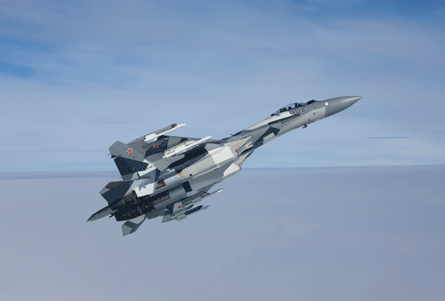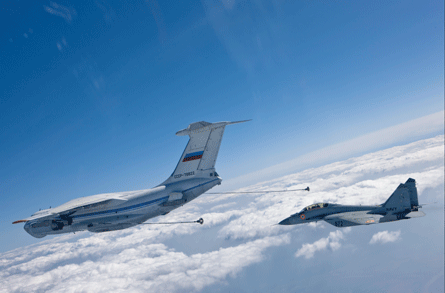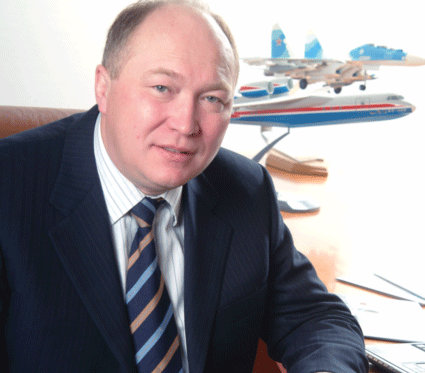For the colossus that is Russia's aerospace industry, matters are coming to a head. The newly created United Aircraft (UAC) has hoovered up the best of the nation's industry, decided which programmes to advance and which to drop, and taken its relationships with Western industry more or less as far as it can for now.
For good or ill it has to proceed with the selected programmes, begin spending substantial money and set off down the one-way street of developing and producing new aircraft.
In the military sector. Russia's fighter expertise and solid prospects among its historic allies give it a moderately secure footing, but in the civil world the extent of the challenge facing it is awesome.
Competing with the best of the West's airframers is a daunting prospect for anyone, but UAC now has to do that at the same time as it tackles the wholesale renovation of its manufacturing plants, a socially significant contraction of its workforce, and probably without the host of willing risk-share partners that the likes of Airbus and Boeing can count on.
Overseeing all this is chairman and president Alexey Fedorov, who has so far managed to survive the shark-infested waters between the Putin administration and an industry full of executives fighting for their legacy companies and pet programmes.
|
|
|---|
Interviewed in UAC's downtown Moscow headquarters, however, he is at least superficially relaxed and points out that the "first stage" of the industrial restructuring in a strategy stretching to 2025 is near completion. "Now we own all the Russian companies that design and produce our aircraft. We finish the first stage of our reorganisation during this year," he says.
That in itself is controversial because it risks imperilling the health of the strongest companies by including much weaker ones. One senior Russian aerospace executive comments: "Now it is probably clear to everyone that the mistake with UAC was to put all the companies in one basket - the healthy ones and those on a declining trend."
If Fedorov shares that doubt he does not show it, and declares: "Next year we will push the second stage - we will build at least three different divisions in our company."
Those units are being named UAC Military, UAC Commercial and UAC Special, and Fedorov is pretty clear what they will be producing. Alongside those there is "an idea for several centres of competence" - notably the Aerocomposite composites centre already in creation. Ultimately the military/civil output split is intended to move from 80/20 today to at least 50/50 and, it is hoped, even 40/60.
The military business is built on the Sukhoi and RSK MiG product line-up with the intention of adding the much-discussed Sukhoi PAK FA fifth-generation fighter still due to fly in T-50 prototype form this year. A MiG-35 win in the ongoing Indian fighter contest, in which it is strongly placed thanks to the two nation's historic links in combat aircraft, would secure that division's future for the time being, although a loss would be commensurably serious.
The influential Mikhail Pogosyan, director general of the combined company and previously head of Sukhoi, says: "RSK MiG is undergoing a management system upgrade and eventually it should be compatible with the Sukhoi company system. For instance, we have reorganised project management and introduced the posts of programme directors.
 |
|---|
© Katsuhiko TokunagaThe UAC military division is based on Sukhoi fighters such as the Su-35 and the RSK MiG line-up |
"We do not have any problem with MiG and Sukhoi top management interaction. We have known each other for many years and some people used to work together. The majority of MiG managers retained their positions."
But he says: "The concept of integrating design and production facilities is a real challenge." The aim is to double Russia's export fighter market share from around 10% to 20%.
Fedorov says UAC Special will be responsible for "strategic bombers and things like AWACS". UAC Commercial, however, is more complex and its proposed products are at different development stages. "Most difficult and most important is the civil aircraft. We lost the global market for the last 15 years," notes Fedorov.
As well as the MS-21 midsize airliner and Sukhoi Superjet 100 regional jet, he says the following projects are active: the long-delayed Ilyushin Il-112 light cargo aircraft; a medium cargo aircraft in development with India; the revamped Il-76 known as the Il-476; an as yet unnamed short/medium-range widebody airliner; and the just agreed relaunch of the Antonov An-124 outsize freighter.
The prospects of each of those are markedly different and it is clear that UAC itself has not been in control of the process by which they were selected. Fedorov says: "Superjet was started before UAC, so it is managed by Sukhoi and its daughter company.
"MS-21 started one year ago and UAC is included in this project more deeply. We have a leader which is Irkut, but UAC has deeper input. UAC has a response to design and develop computers for the MS-21 and for Aerocomposite, which is a UAC daughter company that will be concentrated on the composite wing of the MS-21 and future Russian aircraft such as maybe a newer version of the Superjet and the widebody short-range aircraft."
 |
|---|
© Katsuhiko TokunagaThe MiG-29SMT, part of the UAC range: the company hopes to double fighter exports
|
In each case, however, the aircraft have been championed by other interests. Superjet, with its plausible near-term sales-prospects as UAC was being formed, was an easy winner, but the MS-21 has been driven through by Oleg Demchenko, the powerful but controversial head of Irkut.
Ilyushin's Il-476 is likely to be the last gasp of the venerable freighter and has prospects in Russia's traditional markets, but the motivation behind the Il-112 is unclear. And the An-124 production restart, which has only lukewarm support in UAC, has been largely promoted by primary operator Volga-Dnepr Airlines.
The Antonov and Ilyushin projects present UAC with an additional difficulty in that they are not truly Russian. Fedorov says: "Historically all transport aircraft were produced in the former Soviet Union countries - Ukraine and Uzbekistan. Now we plan to start to produce all these inside Russia."
PROGRAMME RATIONALISATION
On the other hand, UAC has succeeded in a degree of rationalisation of the country's programmes. The struggling Tu-204 is to be continued, but will be withdrawn as the MS-21 comes to market, and the Tu-334 regional jet will finally be laid to rest in favour of the Superjet and more utilitarian Antonov An-148.
UAC's market projection for the MS-21 is a production run of 1,200 aircraft within 25 years, of which only 300 are intended for the domestic market. "It is a product for the global market," says Fedorov.
He adds: "It will have a composite structure. For us it is a very big challenge, but that gives us a lot of advantage in the global market. We have a lot of negotiations with some companies in Europe and there should be an agreement by the end of the year. Just the design and development part of that will be with Western partners."
He declines to name candidate partners, but they are understood to be the likes of composite aerostructures specialists such as Aerolia, GKN and Spirit AeroSystems, and the relationships are intended to be risk-sharing.
Fedorov adds: "We are now in pre-design and next year it will be the working design. The first prototype is to be ready in 2013 and first flight in 2014 and deliveries in 2016."
The baseline MS-21-200 is designed around 150 passengers in single-class configuration and will be followed by a 181-seat -300 and 212-seat -400 with basic and extended-range models, plus a very-long-range MS-21-200LR. The aircraft is to be built at Irkutsk.
Fedorov insists that no engine selection has been made, despite suggestions that Aviadvigatel's PS-14 has been given the nod for the domestic version. Russia's engine industry is itself being restructured under the auspices of United Engine (ODK). For the export version UAC will choose from Pratt & Whitney, Rolls-Royce and Snecma/CFM International.
Tender committees are now considering Western proposals on the aircraft and Irkut's Demchenko says: "Most leading Western-based companies are running in this competition. Those who found partner companies in Russia stand a higher chance of winning the tenders."
WHOLESALE MODERNISATION
At the same time as putting together its product line, UAC is having to set about the wholesale renovation and technology modernisation of the national aerospace sector. "We have to plan to be the third global leader in the aviation industry. We talk about the USA and Europe and we have to plan to be the third," says Fedorov.
Part of that plan involves the virtual halving of the nation's aerospace workforce and a marked increase in productivity of the remainder.
Fedorov says: "We are working very hard for the renovation of our personnel. Our biggest problem is to increase the productivity of our companies. We have a plan to increase productivity by 10 times.
"We have about 100,000 employees in all UAC companies and in 2025 we plan to have about 50,000 employees. The total value of our product we have to increase by five times more than at present - so we need to increase our productivity by 10 times.
"It's a 15-year process. We have no plan to fire our employees today or tomorrow. We will change all our personnel over 15 years, which is a very long period of time. There will be some natural retirement and new workers and employees will come to our company. It will be a natural process not a revolution.
"And the quality of these personnel have to be changed dramatically because the new technology in aviation makes a change for us. We have to have personnel who can work with that digital technology of design and production. We are retraining and introducing lean technology. It is the most important work for our personnel."
 |
|---|
© Katsuhiko TokunagaThe military/civil output split is intended to move from 80/20 today to at least 50/50 |
One component of the plan is to turn the Zhukovsky complex near Moscow into a central hub for the industry, a project now being handled by former Irkut senior executive Valery Bezverkhniy. "Zhukovsky will become a centre like Toulouse or Seattle in about 2015," says Fedorov.
The extent of UAC's future international co-operation is uncertain. Much of the Superjet's modest success to date is down to the high degree of Western content and support, which have reassured customers. But with even Fedorov talking about sales aspirations of merely "more than 400 over 20 years" the true benefit that will trickle back to Russia from the programme is not easy to measure.
A Russian executive with another aerospace company who was recently briefed by French vendors on their offerings says: "Most of these companies announced at the beginning that they were subcontractors on Superjet. My first impression is that this aircraft was a development by a French company."
Russia's tight links with Indian aerospace remain in place and UAC is confident of developing future aircraft with its Asian neighbour, but historic links with China may prove harder to maintain given that country's growing aspirations in civil aerospace.
Fedorov says: "We try to make good co-operation with other places like China and India. It is moving very well in the transport and military areas. We don't know how we can have Chinese and Russian strategies together. But I think we can be together in some areas and it would be a good advantage."
Co-operation on aircraft projects with the West, however, has not so far proved simple. The most active programme is the agreement with Airbus to collaborate on production of A320 passenger-to-freight conversions, initially producing kits to support an EADS Elbe Flugzeugwerke (EFW) line in Dresden, and 18 months or so later developing its own line in Russia. A decision on whether to locate at Zhukovsky or Ulyanovsk has still to be taken.
A bright spot is that, for now at least, UAC is adequately funded, although there may yet be challenges during the transition to production of the new models.
So far the federal government has come up with the requested investments partly through a special funding programme for the industry targeted at design and development and partly through support programmes to provide new technology and development of the plants and design bureaus.
INTERNAL INVESTMENT
UAC's component companies have also been providing internal investment, but the global financial crisis has meant that securing money from Russian banks has been largely impossible and an initial public offering originally planned for 2010 or 2011 is now off the agenda. "I don't know for certain when we will be in the market," says Fedorov. "Perhaps 2012 or 2013 - but in any case we will take money from the global finance market."
He concludes: "We have enough money now to continue our programmes. We have no critical situation of financing."
Source: Flight International
























